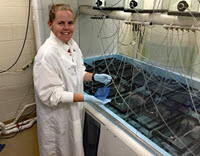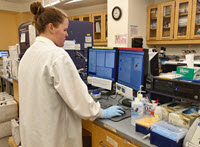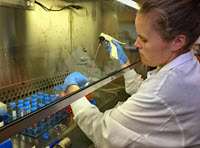
Following Deepwater Horizon, researchers have been conducting multi-year studies on the health of Gulf of Mexico marine life. As part of this effort, Lindsay Jasperse recently studied how marsh fish respond to combined oil exposure and environmental stressors and is currently investigating the immune systems of oil-exposed bottlenose dolphins.
Lindsay is a Ph.D. student with the University of Connecticut’s Department of Pathobiology and Veterinary Science and a GoMRI Scholar with the Consortium for Advanced Research on Marine Mammal Health Assessment (CARMMHA).
Her Path

Lindsay grew up in New Jersey, where she spent her summers at the beach and developed an interest in marine research. She was an undergraduate student at the University of Connecticut when she discovered her love for lab work. Most science classes for her Molecular and Cell Biology major and Physiology and Neurobiology minor included a lab component, and she loved applying classroom lessons to hands-on experiments.
As part of her undergraduate Honors Thesis requirements, Lindsay joined Dr. Sylvain De Guise’s lab team, who was funded through the Morris Animal Foundation, to investigate how eastern oysters respond to oil and Corexit exposure. She loved the research and continued with De Guise’s lab team as a pathobiology Ph.D. student on their GoMRI-funded sheepshead minnow and dolphin research project.
Her Work
Lindsay’s research spans two GoMRI-funded research efforts. Her dissertation research was with the project The Combined Effect of Environmental and Anthropogenic Stressors on Fish Health, which investigated effects on sheepshead minnow reproduction and development. “While fish can adapt to variable estuary conditions, it is not well understood how fish respond to the additional stress of oil exposure,” she explained. “Moreover, environmental conditions such as dissolved oxygen levels and salinity can have a major influence on the uptake and outcome of contaminants in fish.”

Lindsay and her colleagues conducted experiments with sheepshead minnows using high-energy water accommodated fraction or HEWAF under different environmental stressors, including hypoxia and low salinity. They counted eggs produced and fertilized to monitor reproductive success and analyzed eggs for heart rate, length, and survival. They observed that hypoxia and low salinity intensified HEWAF effects on minnow reproduction, perhaps contributing to developmental problems in their offspring. Two generations of minnows showed impaired ability to capture prey, suggesting possible transgenerational effects on this species. “These data indicate that environmental stressors need to be considered in oil spill risk assessments,” said Lindsay. “We hope that the data from my dissertation can inform remediation efforts following a future oil spill.”
While completing her dissertation, Lindsay became involved with CARMMHA’s investigation on bottlenose dolphin health. Dr. De Guise’s team previously observed that oil-exposed dolphins exhibited immune system impairment, including abnormal proliferation of T lymphocytes (T cells) and a cytokine shift towards a T helper 2 (Th2 cells), which could alter the dolphin’s infection resistance and increase its susceptibility to diseases. “T cells are responsible for cell-mediated immunity,” explained Lindsay. “T helper 1 (Th1) cells stimulate cell-mediated immunity to help combat intracellular pathogens, Th2 cells stimulate antibody-mediated immunity to help combat extracellular pathogens, and regulatory T cells (Treg) dampen the immune response and are critical for immune tolerance.”

Dr. De Guise’s team is now developing techniques to determine the pathways involved in immune system alterations. Using blood samples collected from a reference dolphin population, Lindsay’s team validated novel methods that identify and quantify Treg cells. The team also demonstrated how specific cell-signaling proteins called cytokines can help researchers better understand how T cell subsets function, including how they stimulate dolphin T cells and induce increased Th1 and Treg gene expression. They are using these new tools to determine subtle differences in immune system functioning in oil-exposed and reference dolphins. Lindsay and her colleagues are investigating if in vitro T cell exposure to oil alters T cell proliferation or subset function and using an in vivo mouse model to assess immune system impairment and the potential relationship between Tregs and reproductive failure.
“All of these methods allow us to determine the specific pathways being affected by oil exposure,” explained Lindsay. “This can help us predict what health effects the dolphins are likely to have after oil exposure and how likely (or not) they are to recover.”
Her Learning
Lindsay’s work with Dr. De Guise taught her diverse immunology and toxicology assessment techniques and showed her the value of collaborative science. Their team’s projects are highly collaborative, involving institutions from across the country and overseas. “I’ve seen first-hand how much more can be accomplished when labs work together towards a common goal,” she said.
Lindsay gained valuable experience presenting her research at scientific meetings, helping her become a more effective and confident communicator. She received a James D. Watkins Student Award for Excellence in Research at the 2019 Gulf of Mexico Oil Spill and Ecosystem Science Conference. Lindsay described a particularly memorable experience when a large ice storm passed through Mobile, Alabama, during the 2014 conference, “Being from the Northeast, I’m used to snow and ice, but I have never seen anything like that before! The entire city was covered in a sheet of ice.”
Her Future
Lindsay will defend her thesis in May 2019 and then hopefully obtain a post-doc or other research-oriented position. She said that students considering a science career should practice their written and oral communication skills, because effectively communicating one’s research is an important component of the scientific process.
Praise for Lindsay
Dr. De Guise said Lindsay’s exceptional progress as a scientist was rewarding to observe, but not surprising. Even as an undergraduate volunteer, she impressed De Guise and his fellow researchers. “A colleague told me ‘you better keep her!’ She was that much more focused, eager, and fast learning than most undergrads coming through the lab,” he said. He praised Lindsay’s ability to balance working independently with working as a team and keeping focused on the project’s goals. He described her as quick to volunteer and assist others, while managing her own experiments and deadlines with ease. “Lindsay is certainly an exceptionally talented and driven young scientist, with a promising career in front of her,” said De Guise.
The GoMRI community embraces bright and dedicated students like Lindsay Jasperse and their important contributions. The GoMRI Scholars Program recognizes graduate students whose work focuses on GoMRI-funded projects and builds community for the next generation of ocean science professionals. Visit the CARMMHA website to learn more about their work.
By Stephanie Ellis and Nilde Maggie Dannreuther. Contact sellis@ngi.msstate.edu for questions or comments.
************
The Gulf of Mexico Research Initiative (GoMRI) is a 10-year independent research program established to study the effect, and the potential associated impact, of hydrocarbon releases on the environment and public health, as well as to develop improved spill mitigation, oil detection, characterization and remediation technologies. An independent and academic 20-member Research Board makes the funding and research direction decisions to ensure the intellectual quality, effectiveness and academic independence of the GoMRI research. All research data, findings and publications will be made publicly available. The program was established through a $500 million financial commitment from BP. For more information, visit https://gulfresearchinitiative.org/.
© Copyright 2010-2019 Gulf of Mexico Research Initiative (GoMRI) – All Rights Reserved. Redistribution is encouraged with acknowledgement to the Gulf of Mexico Research Initiative (GoMRI). Please credit images and/or videos as done in each article. Questions? Contact web-content editor Nilde “Maggie” Dannreuther, Northern Gulf Institute, Mississippi State University (maggied@ngi.msstate.edu).
